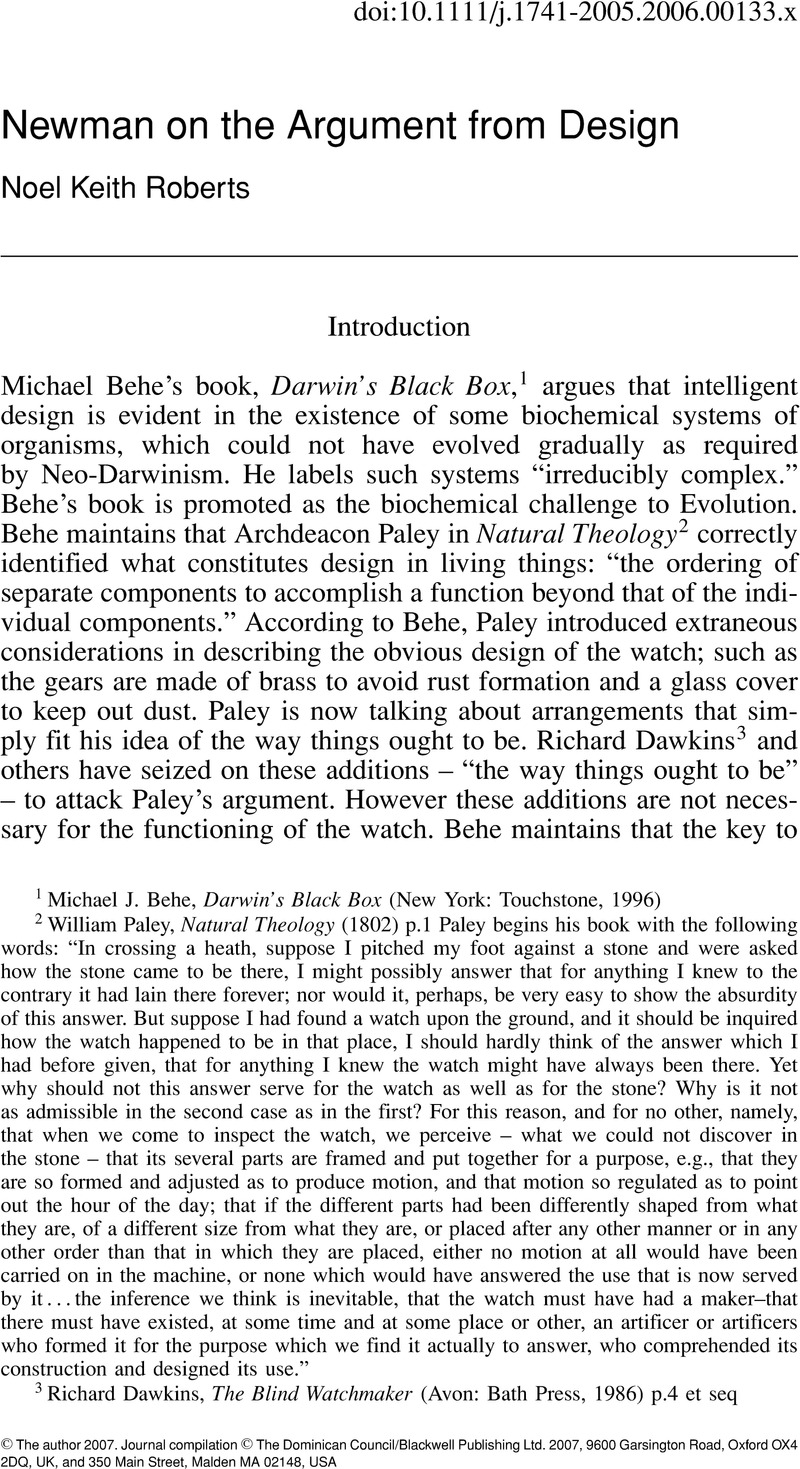Article contents
Newman on the Argument from Design
Published online by Cambridge University Press: 01 January 2024
Abstract

- Type
- Original Articles
- Information
- Copyright
- Copyright © The author 2007. Journal compilation © The Dominican Council/Blackwell Publishing Ltd. 2007
References
1 Behe, Michael J., Darwin's Black Box (New York: Touchstone, 1996)Google Scholar
2 William Paley, Natural Theology (1802) p.1 Paley begins his book with the following words: “In crossing a heath, suppose I pitched my foot against a stone and were asked how the stone came to be there, I might possibly answer that for anything I knew to the contrary it had lain there forever; nor would it, perhaps, be very easy to show the absurdity of this answer. But suppose I had found a watch upon the ground, and it should be inquired how the watch happened to be in that place, I should hardly think of the answer which I had before given, that for anything I knew the watch might have always been there. Yet why should not this answer serve for the watch as well as for the stone? Why is it not as admissible in the second case as in the first? For this reason, and for no other, namely, that when we come to inspect the watch, we perceive – what we could not discover in the stone – that its several parts are framed and put together for a purpose, e.g., that they are so formed and adjusted as to produce motion, and that motion so regulated as to point out the hour of the day; that if the different parts had been differently shaped from what they are, of a different size from what they are, or placed after any other manner or in any other order than that in which they are placed, either no motion at all would have been carried on in the machine, or none which would have answered the use that is now served by it … the inference we think is inevitable, that the watch must have had a maker–that there must have existed, at some time and at some place or other, an artificer or artificers who formed it for the purpose which we find it actually to answer, who comprehended its construction and designed its use.”
3 Dawkins, Richard, The Blind Watchmaker (Avon: Bath Press, 1986) p.4Google Scholar et seq
4 Newman, John Henry, A letter Addressed to the Duke of Norfolk on Occasion of Mr. Gladstone's Recent Expostulation (London: Longmans, Green, and Co., 1900) Vol. II Part 5 p.249Google Scholar.
5 Dessain, Charles and Gornall, Thomas, (eds.) The Letters and Diaries of John Henry Newman (Oxford: Clarendon Press, 1973) Vol 25, p.97Google Scholar.
6 Ibid.
7 Aquinas, Summa Theologiae, 1, q2, a3
8 Aquinas, Summa contra Gentiles 13,35
9 Catechism of the Catholic Church Par.31
10 Ibid. Par.32
11 Newman's Oxford University Sermons, Sermon 10, Epiphany 1839.
When Newman edited this sermon as a Catholic he added an explanatory phrase after “Physical phenomena, taken by themselves;” that is, apart from psychological phenomena, apart from moral considerations, apart from the moral principles by which they must be interpreted, and apart from that idea of God which wakes up in the mind under the stimulus of intellectual training. The question is, whether physical phenomena logically teach us, or on the other hand logically remind us of the Being of a God. In either case, if they do not bring to us this cardinal truth, we are in St. Paul's words. “without excuse.”
12 Newman, John Henry, The Idea of a University (London: Longmans, Green and Co., 1907) p.428Google Scholar
13 Ibid. p.450.
14 Ibid. p.454
15 Ibid. p.449.
16 Ibid. p.454
17 Ibid. p.455
18 Ibid. p.38.
19 Dessain, Charles and Gornall, Thomas, (eds.) The Letters and Diaries of John Henry Newman (Oxford: Clarendon Press, 1973) Vol 25, p.97Google Scholar.
20 Mivart, George, Genesis of Species (New York: D.Appleton 1871)Google Scholar
21 John Henry Newman, Letters and Diaries, Vol XXV, January 25th 1871
22 Ibid. June 5th 1870
23 Genesis of Species Chapter XII
24 Newman, John Henry, Apologia pro Vita Sua, London: Longmans, Green and Co., 1864) p.335Google Scholar
25 Ibid. p.336
26 Newman, John Henry, Callista (London: Longmans, Green and Co,.1855) p.315Google Scholar
27 Apologia pro Vita Sua. p.335
- 3
- Cited by


